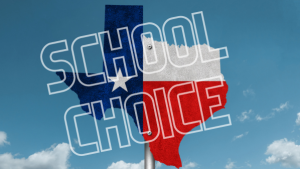Life, Liberty, Property #52: Texas school choice has failed to pass, and Gov. Greg Abbott is having a showdown with Republican legislators.
by S.T. Karnick
IN THIS ISSUE:
- Texas School Choice Showdown
- Republicans Support Democrats’ Fiscal Insanity—Again
- Cartoon
SUBSCRIBE to Life, Liberty & Property (it’s free). Read previous issues.
 Texas School Choice Showdown
Texas School Choice Showdown
School choice will hit a milestone or be crushed under a millstone tomorrow in Texas.
This past fall, the Texas House of Representatives defeated a bill to implement education savings accounts (ESAs) allowing taxpayer dollars to follow the child to the school or other education services of the family’s choice. That bill was blocked by rural Republicans and anti-choice Democrats (which was all of them). Twenty-one Republicans voted against the plan.
Gov. Greg Abbott strongly supported the choice plan and had called multiple special sessions to push the House to vote on education choice legislation the state Senate had already passed.
Following the lead of fellow Republican governor Kim Reynolds of Iowa, Abbott subsequently endorsed primary challengers to Republicans who voted against the choice plan. Abbott said 89 percent of Texas Republican voters approve of school choice.
A recent story in The Texas Tribune indicates that prospective Republican primary voters agree with Abbott:
Sixty percent of Texas Republican primary voters told pollsters that they’d be less likely to vote this March for a state House member who opposed vouchers in 2023’s marathon of legislative sessions. Meanwhile, just 16% [said] they’d be less likely to support incumbents who voted for vouchers.
In an excellent op-ed at The Hill, Texas Tech economics professor Alexander William Salter notes that the rural Republicans’ argument against school choice is incoherent:
GOP opponents of education freedom usually come from rural districts. They argue their constituents are perfectly happy with public schools. But in the very next breath, they claim transferable education funding will destroy those schools.
Of course, these arguments can’t both be true. If parents are happy with their schools—and in rural districts, it seems they are—then they won’t take their funding elsewhere. It’s illogical to argue that no one wants education freedom and also that giving people education freedom will result in drastic change.
Logical inconsistency does not stop choice opponents, of course, In Texas as elsewhere, the press and other school choice haters commonly mischaracterize education freedom as draining funds from government-run public schools. That is false: when students leave those schools for ones that they and their families find more congenial, some or all of the state taxpayer money assigned to that student stays with the government school for a designated time. With choice, the government schools can end up with more money per student than before.
It turns out, however, that the education establishment does not just want more money per student. Teachers and education administrators want access to all the children they can rope into their rotten institutions of indoctrination and mental torture. Thus, they oppose choice even if it provides their schools with more money per student.
The teachers unions are central to this dynamic. Each teacher in a government school typically ends up in the union—the unions and schools make it as difficult as possible for teachers to opt out, in the wake of the U.S. Supreme Court ruling that teachers cannot be forced to join unions. More teachers in government schools equals more money for the union. The unions benefit from governments keeping children trapped in these schools.
The media openly side with the unions. The Dallas Morning News predictably depicts the Texas Republican school choice opponents as heroes, starting with a description of a devoted government-school teacher volunteering to sell concessions at school soccer games, about which we are obviously being prompted to say, “Awwww!” The lesson is that the local government-run school is a precious place that binds the community together:
“I truly believe the school district is the heart of our town,” said Melanie Stubblefield, who teaches music in the fourth, fifth and sixth grades at Travis Elementary School in the Mineral Wells district, which has about 3,230 students spread across its seven schools.
Well, I truly believe that The Heartland Institute is the heart of our nation. Now give me your money!
(Sound of crickets.)
The story continues with an extensive hagiography of choice opponents, describing them as “stalwart,” “defiant,” “nonpartisan,” “respected incumbents,” and concerned about “the future of conservative, rural life”:
A slate of defiant Texas GOP lawmakers agrees [with Stubblefield]. Last year, they repeatedly refused to support a school choice proposal championed by Republican Gov. Greg Abbott. The program would have allowed any Texas student to use public money to offset the cost of private-school tuition, but skeptical lawmakers worried the plan would divert dollars from public schools, tightening district budgets without a proportionate reduction in costs.
The story goes on to intimate that opposition to school choice in Texas is comparable to Martin Luther’s posting of his Ninety-Five Theses on the door of the cathedral in Wittenberg:
“Abbott wanted them to bend the knee and kiss the ring, and they’re just not going to do it. That ain’t Texas,” said Rev. Charles Johnson, executive director of Pastors for Texas Children, a public-school advocacy group. “It is Texan to vote in the interest of your community and constituents.”
The comparison of Abbott to the Pope is amusing.
The angle the story takes is that school-choice opponents are the real conservatives: “There’s nothing more conservative than supporting our public schools,” the story quotes Rep. Glenn Rogers (R-District 60) as saying. Rogers is one of the incumbent anti-choice Republicans whose primary-election opponent Abbott supports.
There’s also nothing more conservative than massive government deficits, Obamacare, social media censorship, ending fossil fuels, rampant urban crime, and drag queen story hour, I suppose.
Although the story does provide the main facts about the situation, the reader is forced to wade through a large amount of this polemical material to find it, and it is written from an explicitly anti-choice point of view.
There’s a reason for that. Those readers intrepid enough to voyage all the way to the end of this Dallas Morning News story are rewarded with the information that it “was produced by The Hechinger Report, a nonprofit, independent news organization focused on increasing inequality and innovation in education.”
That publication is in fact devoted to increasing inequality and preventing innovation in education by opposing choice and competition, confining taxpayer education funding to government-run schools. The website provides articles such as “STUDENT VOICE: My state supports public school choice, and I’m grateful for the options” and this gem about the use of “culturally responsive” math: “How many Cardi B Birkin bags does it take to improve math scores?”
The latter story tells of the efforts of the developer of the I’m W.O.K.E. Project to get children interested in mathematics by “infusing cultural relevance.” That ought to wake those kids up to the hip-hoppy joys of differential equations.
As Salter notes (in nicer words than I am using), Texas Republicans who oppose school choice must be misinformed, cowardly, or corrupt:
The merits of school choice are obvious—the problem in Texas is the Republican holdouts. Some of these representatives are likely well-intended but misinformed. While that may not be a moral failing, it does suggest a lack of prudential judgment sufficient to disqualify them from public office.
But many of these legislators oppose school choice because the largest interest group in their district is the public school system. School choice won’t harm students or schools, but teachers unions, education bureaucrats and others are worried it will diminish their government-granted privileges. That’s not a good enough reason for Republican representatives to act against their party and their constituents. Yet act against them they do—often while taking campaign contributions from teachers unions and sending their own kids to private school.
The system is fighting back as hard as it can, with teachers intent on stuffing the ballot boxes (legally, of course) for school choice opponents, Fox 7 Austin reports:
According to the [Texas American Federation of Teachers] poll, 92% said they will be voting in the March primary and a large majority listed school choice as an issue of concern. Those are big numbers considering that with a statewide membership of 66,000, Texas AFT represents a potentially powerful voting block at the ballot box.
What is at stake in Texas is whether the state’s children will be forced into a system run for adults at the expense of children, parents, and taxpayers, or will finally be freed from it.
We will find out tomorrow whether what worked for Reynolds will work for Abbott—and Texas schoolchildren.
Sources: The Hill; The Texas Tribune; Fox 7 Austin
 Republicans Support Democrats’ Fiscal Insanity—Again
Republicans Support Democrats’ Fiscal Insanity—Again
So, … another day, another deal to avert a partial government shutdown by spending more of present and future taxpayers’ hard-earned money. The temporary spending (“stopgap”) bill the Republican-“controlled” House of Representatives passed on Thursday is designed to keep federal agencies in operation while the House and Senate work on proper appropriations bills.
The bill passed 320-99, with just over half of the House Republicans voting in favor. Nearly all Democrats voted yes. The bill needed approval by two-thirds of those voting.
House Speaker Mike Johnson and other congressional leaders say they have reached agreement on six of the twelve appropriations bills, and the stopgap bill will give them time to carve up the taxpayers finish the rest of them this month.
“The final contents of the bills are not yet clear, though it appears that the bills will not feature the big conservative policy wins House Republicans were pushing for,” Roll Call noted. (That’s some understatement.) “[Senate Majority Leader Chuck] Schumer said Thursday that the package would not include ‘unacceptable poison-pill riders that we said would not fly.’”
You can be sure of that. Democrats do not back down from a fight when it comes to spending other people’s money.
Note that things Republicans want are “poison.” I’m still waiting for Republicans to start referring to Democrats’ spending priorities as “heroin” or “fentanyl.”
In the face of such withering criticism (sarcasm note), “‘All we seem to offer is low energy and low [testosterone] in the face of these mounting challenges,’ Rep. Matt Gaetz, R-Fla., said,” Roll Call reported. Gaetz earns an A for accuracy on that one.
Congressional leaders say that the appropriations bills will reflect the overall spending level agreed to in last year’s debt ceiling deal. That agreement set a cap of 1 percent on spending increases for the 2025 fiscal year. The FY2024 federal budget deficit is forecast to be $1.846 trillion, out of a budget of $6.883 trillion, meaning approximately 27 percent of the budget is already deficit-financed. This deal will not exactly improve the situation.
In last year’s debt ceiling fight, you might recall, “Some Republican lawmakers had insisted on deep cuts laid out in a bill passed by the House in April, which would have rolled back spending levels to fiscal 2022 and then capped growth at 1% for a decade,” as The Wall Street Journal reported at the time. “Democrats had called those cuts a nonstarter.”
And because Democrats have nerve and stand for something—impossible, irrational, irresponsible, unsustainable government spending—they got a deal that increased the budget bloat.
Within that debt ceiling deal, however, was a provision requiring a 1 percent cut in federal spending if any of the appropriations bills did not get passed by an agreed-upon deadline (originally set for the end of 2023). The legislation the House passed averts those cuts, if the Senate agrees and President Joe Biden signs the legislation, as they surely will.
The Democrats were willing to stick to their guns and force a government shutdown, all to stave off a measly 1 percent spending cut. The Republicans were not willing to risk anything to get even a largely symbolic 1 percent cut in spending.
Kudos to the 97 Republicans who voted no. I don’t know what the two Democrats who voted no were thinking. They probably thought the bill does not spend enough.
As a result of this deal, the federal deficit will surely increase, the federal debt will balloon further, payments on the government debt will cost even more than they do now, and the massive weight of the federal government on the nation’s economy will increase.
A local television station’s news program referred to this latest budget deal as “a crisis averted.” It may be that in political terms, but it is only going to add to the federal budget crisis.
This is what the U.S. press call governing responsibly. It is in fact what people who have mastered simple arithmetic call fiscal insanity.
Source: The Wall Street Journal
Cartoon

via Comically Incorrect











